Visual clues at the Fairfield County Infirmary Pt II
Yesterday we started reviewing a site visit to the Fairfield County Infirmary. Today we’ll take a look at a sandstone outbuilding on the property.
When I mentioned my excitement yesterday about the outbuildings, these pictured below were a big source of the excitement. Too often, unfortunately, these buildings are lost.
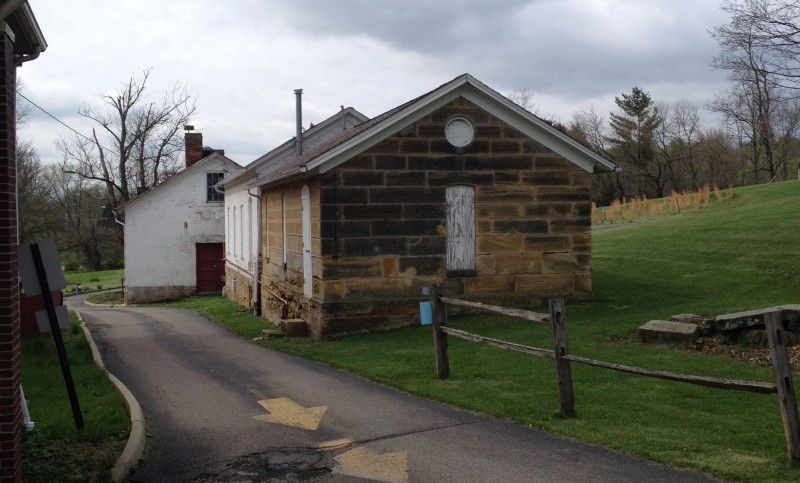
The outbuildings on a site can provide a richer detail of the day-to-day existence of the residents. Whether they were constructed with inferior materials or techniques, or decisions about ongoing maintenance focused on the main building to the detriment of the other buildings on the site, outbuildings can be too quickly and too easily lost to demolition.
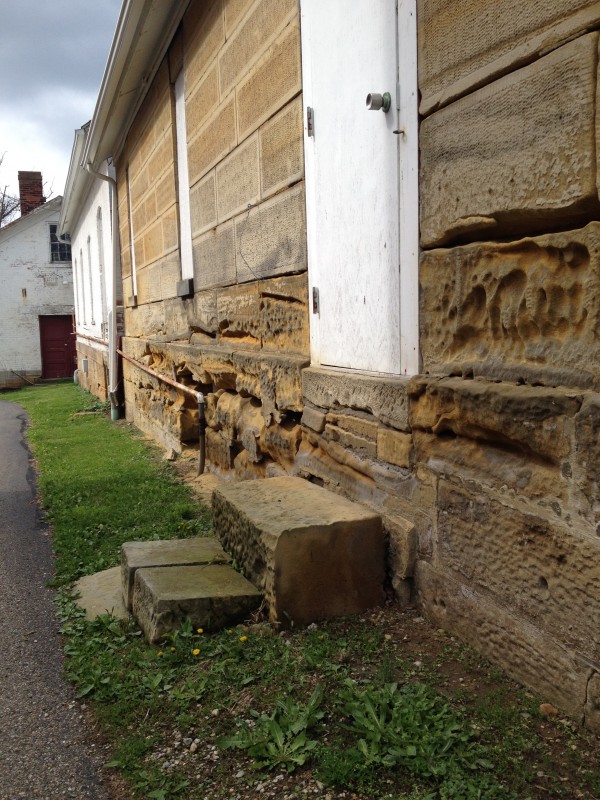
The building in the foreground was well-constructed (obviously) with sandstone block composing the walls. But even a building material as sturdy as sandstone block can fall prey to the dangers of moisture. During the summer we may have hot and humid air just outside of this building, while the air temperature inside could be significantly cooler. Just like a cup of cold water will “sweat” in the hot summer air as water vapor condenses on its surface, water vapor in the air will condense on the cooler sandstone. While sandstone is an incredibly strong stone, its strength is compromised when wet, allowing deterioration to occur. In winter, when the warmer, wetter air in the interior of the building hits the colder, drier air, we have condensation, and ice.
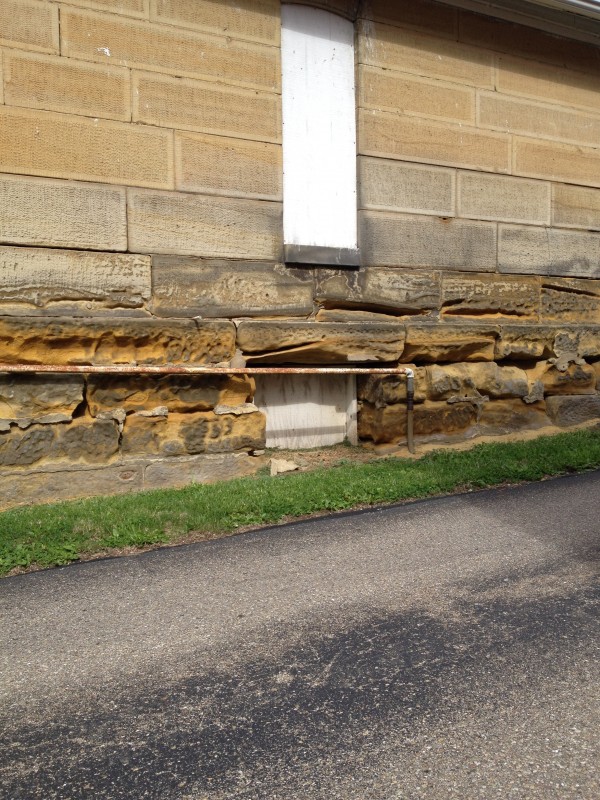
The condensation and freeze/thaw cycles on the building contribute to an almost constant deterioration cycle. The moisture will attack the inherently weaker areas in the sandstone, and given 150+ years, the sandstone will show the pockmarked appearance, as the sandstone loses its binder. Working to equalize humidity and temperature levels between the outside and inside of the building will help to slow the deterioration. Otherwise, the owner of the building will have a large repair bill in the future, having to replace or restore the sandstone.
Given the location of the road and its proximity to the sandstone outbuilding, it’s also possible that salt-laden snow has been repeatedly piled against the lower wall. Any dissolved salt that penetrates the stone and refreezes will certainly speed deterioration of the stone. It’s important to try to keep all the possibilities in mind when assessing buildings and the site.
I’ll finish today’s post with a couple site photos, since the setting of the infirmary seemed very peaceful, especially on the day we visited.
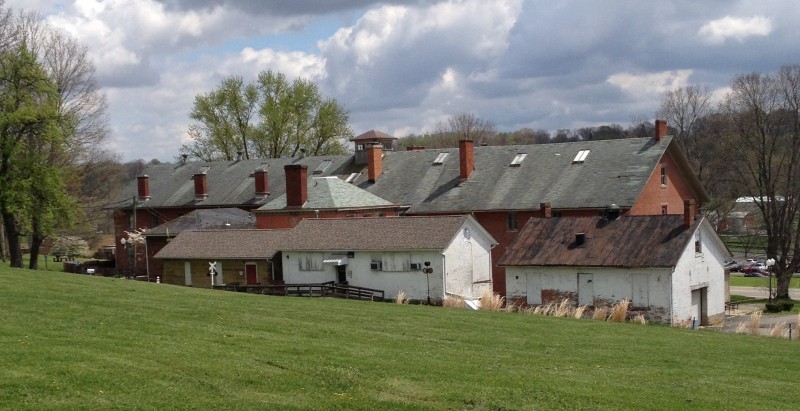
With these two images of the back elevation and front facade of the building, you can get a sense of the topography of the site. Add active springs into the mix, and site drainage becomes an even more critical issue. There are places in the main building where you can hear the rush of the underground springs as they channel the water through the property.
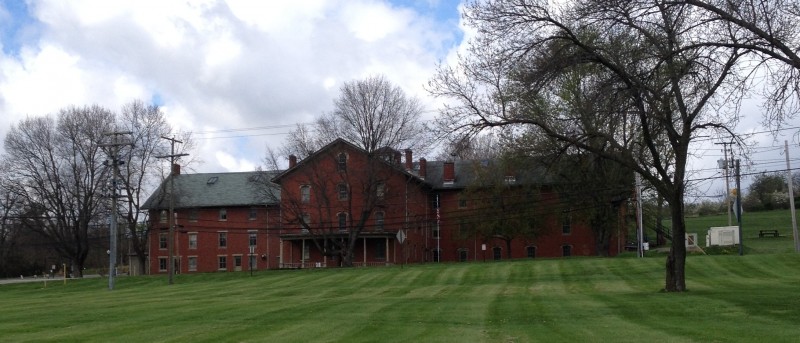
The front lawn in this image is actually on the other side of Route 37. The county owned nearly 2,000 acres, I think, at its height for the infirmary site, but most of the land has been parceled off and sold. The lawn in this picture is part of OU’s Lancaster branch site.
We’re keeping close tabs on the fate of the complex and we’ll be sure to keep you updated as we learn new information. Thanks to Jon Slater, Fairfield County Auditor, and Dennis Keller, Facilities Manager, for hosting us and giving us a peek into an important piece of Fairfield County history!
Visual clues at the Fairfield County Infirmary Pt I
Back in early May, Jeff and I visited the Fairfield County Infirmary. The main building is commonly known as the Miller Building. The campus is located on State Route 37, north and east of downtown Lancaster. The site is hilly and very picturesque, with underground springs that originally provided the water needs for the campus.
Jeff and I visited that day to tour the site with Fairfield County officials. The campus is nearly 100% vacant currently, and commissioners have sought ideas for redevelopment (thankfully, they are entertaining redevelopment options that include the preservation and continued use of some, if not all, of the buildings located on the site).
It was a thrill to tour through buildings dating to the 1820s, and to see so many of the site’s outbuildings that had survived, some in continued use even today. As we toured I paid special attention to what was happening with the buildings and the site. I kept in mind questions such as: how do the locations of buildings on the site (and the grading on the site) contribute to the protection of buildings and materials, or contribute to their deterioration; how have alterations and repairs protected buildings or sped their deterioration; and how have differences with temperature and humidity affected building materials. I’ll report on what I found over the next couple posts.
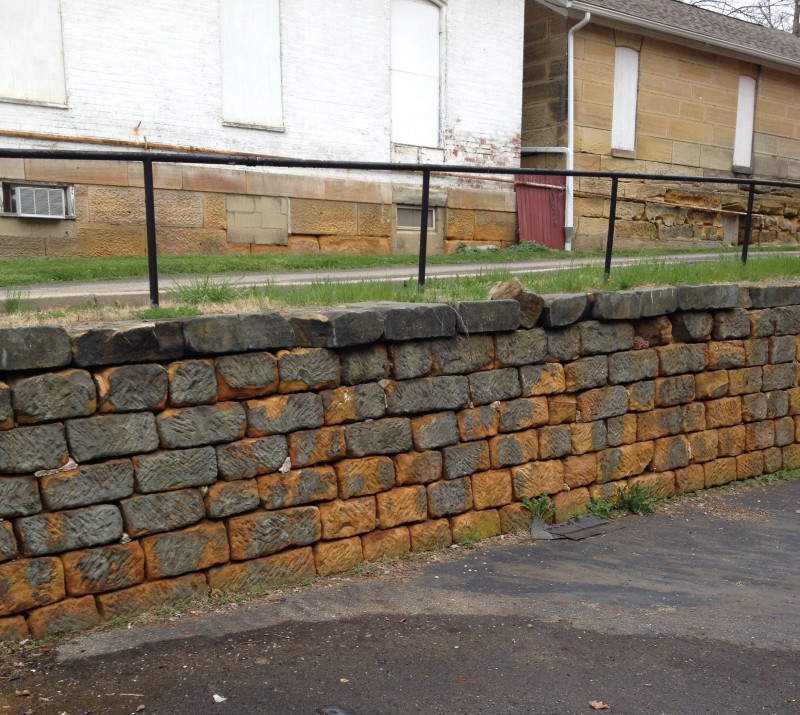
While it was initially puzzling to see this distinct two-toned appearance on the sandstone retaining wall, a closer investigation of the individual blocks points to a probable cause.
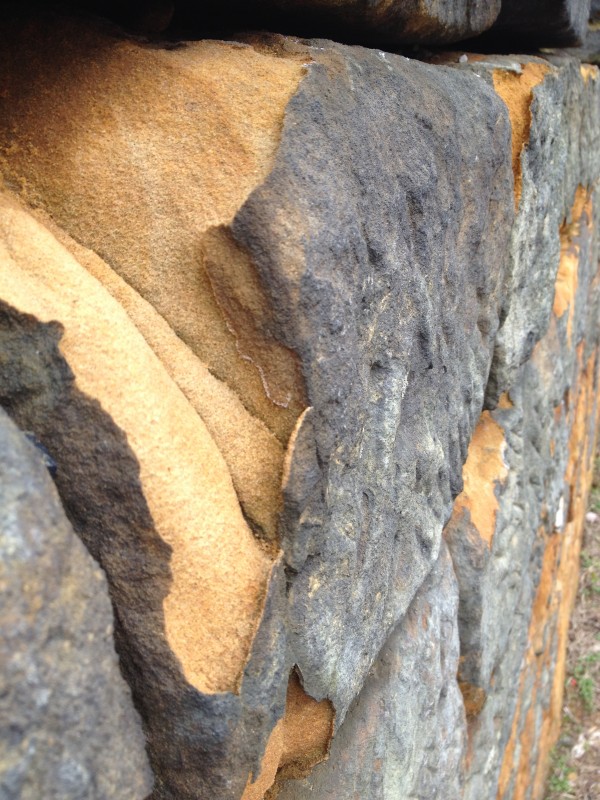
The two detail shots show what appears to be an intact stone crust, but a deteriorated interior structure. This means that water or water vapor was likely trapped within the stone. In other words, the surface of the stone became impermeable, not allowing trapped water or water vapor to pass through. Typically, if a stone or brick is coated with an impermeable sealer, the water or vapor collects against the inside face of the stone. The sustained wetness, not to mention freeze-thaw cycles, will cause the continual deterioration of the stone, as the water cannot escape, while the outside face of the stone appears relatively sound.
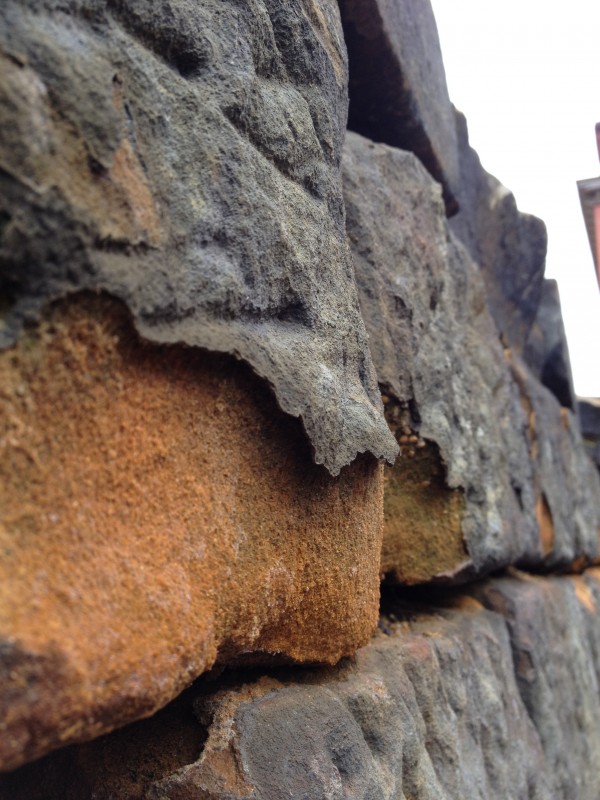
The sealed or “protected” face of the stone remains relatively deterioration-free, until the complete disintegration of the interior structure of the stone causes the crust to flake off, due to a lack of any internal support.
These images provide a perfect example of why I get nervous any time I hear someone talking about the need to “waterproof” or “seal” a masonry surface. While there are sealers that work well with masonry when there is a true need, so many times we see the sealer doing more damage than good because: 1) the masonry wall does not actually need to be sealed, and, 2) the sealer does not allow water vapor to pass through, trapping interior moisture within the masonry, speeding up deterioration.
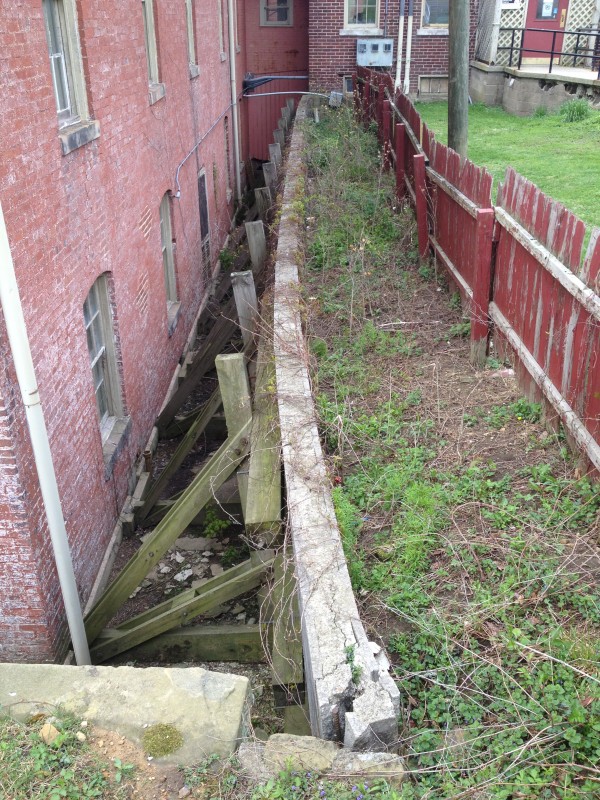
There’s no mistaking that masonry can be a very strong building component, when used the right way. When masonry is stacked, such as the brick used in the building in this image, its ability to hold up the structure and work against gravity is impressive. However, masonry is no match for forces pushing against a wall (as opposed to forces such as gravity, which pushes down through the wall, not against it). Here, a single thickness concrete block retaining wall shows a visible bow as the pressure exerted by the earthen hill exceeds the strength of the bond between the block and the mortar in the retaining wall.

What I really like about this image is the well-worn sandstone door sill. On the day this sill was placed, the plane across the top of the stone was level and straight. The wear we see in the image is the tangible evidence of the people that came before us, thousands of steps coming into or out of the building, crossing the threshold.
Also interesting to note is the lower rail of the screen door. Instead of fabricating the typical rectangular shape, someone accounted for the gap created by the wear and cut a custom fitted rail, conforming to the dip in the stone.
I’ll be back tomorrow with more visuals from our visit, and more thoughts about the different forces acting upon the buildings.
Preservation trades annual conference coming back to St Clairsville!
I’m so excited to let you know that the Preservation Trades Network is bringing its annual conference (the International Preservation Trades Workshop, or IPTW) back to Ohio, specifically to St Clairsville! On September 12 and 13, Belmont College’s campus will become an unparalleled learning center for attendees to watch countless demonstrations related to the building trades. Promising 30+ traditional trade demonstrations in 10 different tracks, PTN’s workshop will truly have something for everyone.
However, it won’t just be about learning. There’s a Wheeling Pub & History Crawl, awards dinner and auction, *and* Trades Olympics! (I suppose I better get those chisels sharpened.)
So, it’s one thing to be excited about this year’s IPTW and the great opportunities to watch demonstrations, but I’m doubly excited because Belmont College is my alma mater. It’s where I first learned the finer points on reconstructing a sandstone foundation wall, learned how to recondition old wood windows to function like new, learned how to repair plaster, how to create new stained glass and restore historic stained glass, learned stone carving. Oh, and learned how systems like plumbing and electrical work in a house.
Preservation and the trades have become so intertwined both in my personal and professional life, that the campus of Belmont is like hallowed ground for me…where it all started for me, if you will. Although it’s been almost 20 years since I was a student at Belmont, to this day I’m still actively putting into practice what I learned there, so coming back to brush up on the trades, learn new tips and techniques, or to just be amazed by the talent and ability on display will be an amazing privilege to experience.
Online registration is open now. Just go to ptn.org and click on IPTW 2014. I hope to see you there!
Countering demolition arguments…or beating the "George Washington slept here" mindset
When I was young my parents shuffled me and my sister around the country to take in our country’s landmarks during the summer family vacations. With only enough time to hit the highlights of American history, we grew up with a narrow perspective of what it meant for something to be “historic.” Historic was a term reserved for east coast taverns where George Washington slept, Independence Hall in Philadelphia where our founding fathers toiled over the wording to the Declaration of Independence, and Lincoln’s boyhood home in Indiana (itself a replica, but nonetheless, a “historic” replica).
History was synonymous with national importance, but there was some room for folks with state importance: governors, semi-mythical figures, and such. What really didn’t have that heritage cache, though, were the local historic districts, whether residential or commercial. Each district had many fine, old buildings, but we didn’t travel to Madison, Indiana, to take in their huge landmark districts and learn about their old buildings. I’m guessing a lot of people were raised with the bias about what constitutes historic versus non-historic, and whether we could still consider all of the places where Washington *didn’t* sleep as historic in their own right.
While that began to change in the 1930s as communities such as Charleston, South Carolina, and New Orleans designated local historic districts, giving residents on a board of architectural review the power to stop the demolition of historic resources, the Penn Central case in the 1970s seemed to put the federal government’s stamp of approval on the designation and protection of historic resources in local districts. In other words, we were beginning to figure out that a wide swath of our history and architecture was important, was worth preserving, and was worth protecting against demolition.
How things have changed, collectively, in the last 25-30 years.
What's on the grocery list? Milk, bread, support for Heritage Ohio?
Yes, you can shop and assist Heritage Ohio at the same time, and it’s easy to do. Once again, Heritage Ohio is a nonprofit partner in Kroger’s Community Rewards program. What does that mean? Quite simply, each shopping trip to Kroger means a small donation for Heritage Ohio. And those small donations really add up. In fact, we’ve received over $900 to date, from people doing their everyday shopping at Kroger!
We’d love to have you as part of our Kroger shopping army, benefiting Heritage Ohio with each purchase. It’s easy to set up your Kroger Plus Card to direct your Community Rewards to Heritage Ohio. You can learn more and sign up here. If you sign up, let us know, so we can give you a proper thanks!
Curious about our photo contest winner?
We’ve announced the winner in our Preservation Month 2014 Photo Contest. You can find out who snapped the winning picture here.
Preservation Month 2014 Photo Contest…vote now for your favorite!
Happy Preservation Month! Our photo contest is back, and we have 5 finalists this year vying for the winning vote, and their image on the cover of Revitalize Ohio. Click here to open the contest page, view the finalists, and vote for your favorite! Voting is open through May 22, and we’ll announce the winner on May 23. May the best image win!
Nominations open for Heritage Ohio's Annual Awards
Earlier this week we opened our call for nominations for the Heritage Ohio 2014 Annual Awards. The annual awards recognize the best in the state for historic preservation and downtown revitalization in categories such as Best Public/Private Partnership, Spirit of Main Street, Best Commercial Rehabilitation, and (new this year) Historic Farmstead of the Year! You can learn more about the award categories here.
We will accept award submissions through Friday, May 23, with judging in June. We’ll honor the award winners at a special ceremony during our Annual Conference in Kent on September 23.
So, if you have a project or person that deserves special recognition in the world of historic preservation or downtown revitalization, we invite you to complete and submit a nomination form for judging. Good luck!
Young Ohio Preservationists
Update 3/1/2016: The Young Ohio Preservationists have become a reality and are located at youngohiopreservationists.org!
One of my absolute favorite blogs is Preservation in Pink, so I found her post a few weeks back about young preservationists especially interesting. As you may be aware, Heritage Ohio has been active in working to help build a Young Ohio Preservationist movement, from developing a survey to get feedback about how 20-40 year old self-identified preservationists view themselves shaping preservation in Ohio, to holding one-on-one stakeholder interviews, to holding introductory planning meetings in Columbus this past January.
As the PiP author expresses in her blog post, preservationists in leadership positions have done a better job in recent years of actively engaging people under 40 to help shape the preservation movement. Although some bristle at the notion that a “Young Preservationist” appellation is even needed, preferring instead to seamlessly mesh with the rest of the preservation world, the concept of giving young preservationists special status within the preservation world has taken hold. A lot of Old Preservationists (myself included) are excited by the prospect of fresh ideas, and new ways of looking at (and saving) old buildings that young preservationists can bring to the table.
What do you think? Is there a place in the preservation world for groups of a specific age range?
![]()
IRS rings in 2014 with more clarity on tax credit structure
A somewhat quiet, but nonetheless controversial, tax credit ruling erupted in August of 2012, when a court decision found that a development partner in a historic rehab was not, in fact, a bona fide development partner. What did this mean? Quite simply, this ruling had the potential to take redevelopment partners, often the development partners who put upfront construction money into a project, off rehab projects. And removing the funding source to make construction happen means stopping rehab projects in their tracks (this article from the Canton Repository shows how the Boardwalk decision hit home in Ohio.)
Without clear guidelines on how the IRS would treat development partners, active investment has lagged in the past 16 months. Fortunately, the IRS recently published guidelines to clarify development partners’ relationships, and how those partners can make use of tax credit allocations. The Preservation Exchange, a blog originating from Preservation Studios in Buffalo, NY, published a post providing analysis of what the IRS guidelines may mean for future developer partnership structures. You can read the PE post here.
You can read the IRS guidelines here. Heritage Ohio will continue to monitor the impact of the IRS guidelines and share updates as we learn of them.
Ohio DSA announces Round 11 tax credit recipients
Today the Ohio Development Services Agency announced that 31 buildings in 10 different communities received allocations of the Round 11 tax credits. As in past rounds, the credits were divided for projects throughout the state (although the northwest and southeast regions were absent from this round). While few dispute the power of the credits in making multi-million dollar rehabilitation projects possible (with three separate projects taking the maximum $5 million per project), the state continues to work to make sure smaller projects don’t fall through the cracks. This round of credits included a $65,000 rehab project in Wilmington. The Wilmington project is slated to receive $13,825. You can read the ODSA press release here.
A Small Business Saturday bribe, er, incentive, for American Express cardholders!
Small Business Saturday, the local business answer to Black Friday (and now Tryptophan Thursday) calls on shoppers to patronize their locally owned businesses, injecting some dollars into the local economy. Since 2010 us Main Street types have cheered a day sandwiched between Black Friday and Cyber Monday, giving local businesses some shopping publicity, and now American Express has sweetened the deal for cardholders who shop this Saturday. Here’s the deal: spend at least $10 at a qualifying local business (you can check the list here) and receive a $10 credit on your AMEX statement. However, it appears there are limited “slots” for cardholders to sign up to get this deal, so don’t delay. You can learn more here.
Thank you very much, American Express. I’ll take your $10 bribe and happily do some local shopping on Saturday in observance of Small Business Saturday. I hope you all will do the same. Happy Thanksgiving!
Update: Frank charged some delicious vanilla hazelnut bulk coffee from his favorite local coffee retailer, Cup o Joe, on Small Business Saturday!

